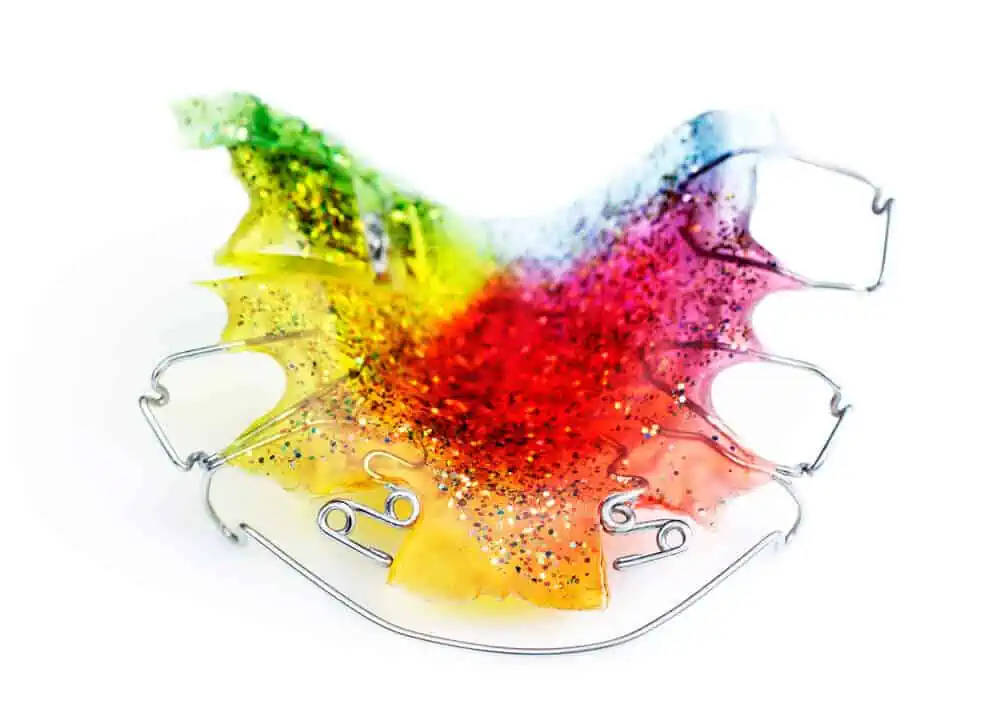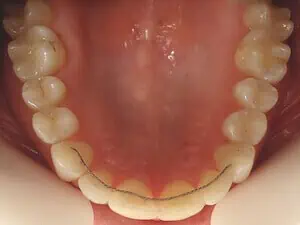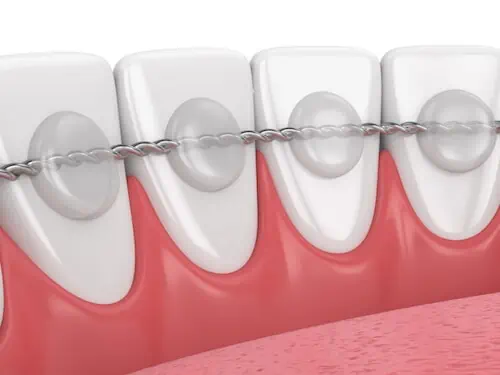If you’ve had your braces removed and your teeth are now straight, your orthodontist may recommend a permanent retainer. Permanent retainers usually last up to 20 years but can degrade faster or slower depending on the level of care.
They are good for people who won’t be compliant with wearing removable retainers every night, but they do require special care when cleaning teeth.
In this article, we’ll answer your questions about fixed retainers for teeth and cover all sorts of information like:
- The overall cost of permanent retainers
- How permanent retainers work
- Pros and cons of permanent retainers
- What happens if they break
We hope this helps you decide if this is your best option after orthodontics treatment!
Did you know? You can order custom retainers online for way less than you can get at the dentist! Have a look at our top picks below:
| ALIGNERCO | Sporting Smiles | NewSmile |
|
|
|
What is a permanent retainer?
A permanent retainer is a metal wire that is positioned behind your teeth to keep them from shifting back to the position they were in before braces. They are permanent because they are bonded with dental cement to your teeth, normally just the front four to six teeth.
There are also permanent retainers made of composite resin instead of metal wires, although typically less frequently used because metal is more durable. Also, metal-wired retainers are bonded using composite resin (the same material used to adhere traditional brackets to the teeth).
Usually, your orthodontist will recommend a wire retainer behind your teeth immediately or six months after removing your braces to ensure that your teeth stay aligned. Some people get permanent retainers fixed to both their upper and lower teeth.
However, dentists are less likely to recommend a permanent retainer for top teeth than permanent bottom retainers because they have a greater chance of breaking prematurely.
Permanent retainers usually involve placement from canine to canine and therefore are stabilizing the anterior (or front) segment of your teeth. It is still possible for teeth in the posterior or back segments not bonded, to move.
Removable retainers can be removed and replaced easily. There are two types:


There are two types of permanent retainers:
- Stainless steel wire (flexible stranded, cylindrical, or flattened)
- Fiberglass-reinforced composite resin
Retainers are very important after the removal of your braces. To avoid the painful and forceful shifting of braces yet again, a permanent retainer gives you a permanent way to keep your teeth in place.
Not wearing retainers after braces can harm your smile and ultimately lead to your orthodontist suggesting braces a second time around.
Permanent retainer pros and cons
Here’s what you need to know about the pros and cons of wearing a permanent retainer.


Pros of a permanent retainer
The most beneficial thing about bonded retainers is that forgetting to put them in is impossible. Once it is in place, you can forget it exists and never have to worry about the caretaking that comes with removable retainers.
This also allows you to avoid all the pain of putting in a removable retainer that has spent too long out of your mouth and on your shelf. Let’s take a look at some of the other pros:
- Visibility: Another benefit to these lingual bar retainers is that they are bonded to the back of your teeth and invisible to everyone else. This differentiates them from some removable retainers, which show a wire across the front of your teeth.
- Affordability: Over time, the cost of a permanent retainer vs. a removable retainer will likely work out to be less as there is no opportunity for it to be lost, and it is much less likely to be broken.
- Lose-ability: A permanent retainer is a “set it and forget it” method of orthodontic treatment that is easy to use and nearly impossible to lose. If this has happened to you, read about not wearing a retainer for a month.
Cons of a permanent retainer
While bonded retainers are a good option for teeth retainers because they have many advantages, they also have some disadvantages. A permanent retainer can make cleaning your teeth difficult, as the wire on a bonded retainer can trap bacteria and food and increase your chance of cavities since flossing becomes more difficult.
When it comes to flossing with orthodontics, you may want to consider purchasing a water flosser for easier cleaning. Read all about water flossers in our best water flosser guide.
Is getting a permanent retainer painful?
Getting a permanent retainer is not painful but can be uncomfortable or annoying as your tongue constantly touches them. But that goes away pretty quickly after getting it in.
Like any other dental device, a built-in retainer can degrade over time. You may have to replace your retainer at some point, and it is much more difficult to replace a permanent retainer than a removable retainer since it requires you to be with your orthodontist to make the fix physically.
Another permanent retainer problem is that bonded retainers have the potential to increase plaque buildup and trap bacteria and be more troublesome to replace or fix if the retainer breaks.
In the following video, one orthodontist explains why he doesn’t like permanent retainers as much as Hawley or Essix.
So you’ve got some things to consider; have a look at the following table for a summary of the pros and cons:
| Pros | Cons |
| Virtually invisible | Makes it more difficult to clean teeth |
| Impossible to lose | Could break requiring replacement or repair |
| You don’t have to remember to put it in | Costs more than removable retainers |
| Lasts for many years | |
If you are interested in getting a removable retainer instead of a permanent retainer, or your dentist recommends one as a supplement to your permanent retainer, you can get custom-made removable clear Essix retainers online from Sporting Smiles.
They make it easy to order your impression kit, make your impressions, and then send them to a lab where professionally trained technicians will craft your clear retainers. You can also choose whether you want standard Essix retainers or Essix Plus, which are extra durable. If you are getting the removable ones, you need to take care of them.
Order your retainers now, and get 10% off your order with promo code SMILE10.
It is important to note that if you require MRI diagnostic imaging for medical purposes, you should have their permanent retainer removed and rebounded after the procedure. It has been proven that the metal permanent retainers will interfere with diagnostic imaging.
How much do permanent retainers cost?
Permanent retainers may cost anywhere between $150 and $500 for one. You may need a bottom teeth retainer and a retainer for your top front teeth as well (up to $1000 for both the lower and upper front teeth).
But what if you shell out up to $1000 for a permanent retainer and you need to have it removed?
Permanent retainer removal costs are anywhere from $150-$500 (this includes the cost of repair and replacement if the permanent retainer breaks on one side).
The price for a permanent retainer is a bit high, but it will ultimately be less than removable retainers, which are more easily lost and damaged. Permanent retainer prices are very reasonable considering their lifespan is upwards of 20 years!
How to remove a permanent retainer?
While a bonded retainer may last 20 years, sometimes the metal retainer attached to the back of your lower teeth or upper teeth is just too annoying, and you will want to remove your fixed retainer. You should never try to remove your permanent retainer yourself, but visit your orthodontist to get it removed correctly.
Attempting to remove a retainer on your own can put your teeth at risk of damage and possibly require your teeth to need further straightening treatment. If the permanent retainer becomes loose, you should return to an orthodontist for fixation.
The “dental glue” used is specialized for dentistry and is safe for the body. Also, if the permanent retainer becomes loose, don’t ignore it because tooth movement can occur.


Conclusion
So now you know that permanent retainers can help keep your teeth in line for many years after orthodontic treatment. There are certainly some disadvantages; they are more expensive than removable retainers and can break over time, requiring retainer replacement or removal.
Ultimately, your dentist can advise you if a permanent retainer is the best treatment option for you.
FAQs
How long should you wear a permanent retainer?
You should wear a permanent retainer for the rest of your life unless instructed otherwise by your dentist or orthodontist. However, at some point, your permanent retainer may break. You’ll have to go in to fix it or apply a new one.
How do you remove permanent retainer glue?
You can remove your permanent retainer glue by going to see your dentist. If your permanent retainer breaks or falls off, you might be tempted to remove the glue yourself at home, but you shouldn’t try this. For your own well-being, go to a dentist or orthodontist to have the glue removed. It’s the only truly safe and effective way instead of trying to get your retainer removed yourself.
How long do permanent retainers last?
Permanent retainers can last over 20 years with proper care, although many people find that a permanent top retainer will fail much sooner than a permanent retainer on the bottom teeth. That’s because it’s subject to a greater biting force.
How much is a permanent retainer?
Permanent retainers cost from $150 to $500 for one, and you can double that for a set. The cost is the same if you need to remove, replace, or fix your lingual retainer. If your retainer breaks, you should see your orthodontist and find out whether they advise its removal or replacement.
Are permanent retainers safe?
Permanent retainers are safe, but there is an increased risk of gum disease and cavities if you don’t keep your permanent retainers clean. If kept clean, permanent retainers are typically not harmful to your teeth.
Can your teeth still move with a permanent retainer?
Your teeth can still move with a permanent retainer, although stabilizing the front teeth typically prevents anterior crowding or movement.
Journal of the American Dental Association: High proportion of postorthodontic fixed retainers seem to survive after 10 years. Consulted 27th February 2020.
American Association of Orthodontists: Will I Need to Wear Retainers After Treatment? Consulted 27th February 2020.
Journal of the American Dental Association: High proportion of postorthodontic fixed retainers seem to survive after 10 years. Consulted 27th February 2020.
American Association of Orthodontists: Will I Need to Wear Retainers After Treatment? Consulted 27th February 2020.




